Physical Address
304 North Cardinal St.
Dorchester Center, MA 02124
Proximal humeral fractures (PHFs) account for nearly 6% of all fractures. They have an overall incidence of 40 in 100,000 patients. This number is predicted to triple by 2030 with a growing elderly population leading to an increase in age-related osteoporosis. As such, management of these fractures will continue to pose challenges on many fronts. From fracture characterization to treatment options and personalized treatment decisions, there is limited guidance from the literature. The individuality of affected patients, fracture pattern, and vascular impairment as well as bone quality makes uniform treatment difficult. Therefore it is particularly important to develop clear evidence and treatment algorithms for the various patient subgroups.
At the beginning of the 20th century, conservative treatment was the mainstay of treatment by default as there were no viable alternatives. With the foundation of the Arbeitsgemeinschaft für Osteosynthesefragen (AO) in 1958, new treatment options with devices for open reduction internal fixation (ORIF) were developed. In 1970 Charles Neer presented his results of hemiprosthetic replacements for proximal humerus fractures. Subsequently, more fractures were treated operatively and with the development of anatomically contoured, angular stable (locking) implants at the beginning of the 21st century, ORIF became the “gold standard” for the surgical treatment of PHFs. The success of these treatments, however, does not just depend on the implants themselves but also upon appropriate patient selection and surgical expertise. More recently there have been some reports of high complication and revision rates. The PROFHER trial, being the largest randomized trial to date on PHFs, has provided high-quality evidence to justify nonsurgical treatment for the majority of low-energy injuries. Understandably, this trial has divided opinion and stimulated vigorous debate. At one end of the spectrum with an undisplaced fracture in an elderly patient, few would dispute the role of conservative treatment. While at the other end with a comminuted fracture-dislocation in a young patient, there is obviously a role for operative intervention. However, a number of more or less displaced fractures in a highly variable spectrum of patients exists in between. The management of those situations currently remains controversial. In this group, the advantage of ORIF over nonsurgical treatment would be weighed against the risk of potentially significant complications.
In addition, the considerations go beyond nonsurgical versus surgical management as the latter encompasses a vast array of shifting and nuanced management options. Within ORIF there are different plate designs, intramedullary (IM) nails, augments with allograft struts and bone graft substitutes, and beyond. More recently, the reverse total shoulder arthroplasty (rTSA) has become a valuable option for treating comminuted proximal humerus fractures, particularly, in elderly patients. , While reports of improved function with low revision rates are promising, long-term follow-up studies have not yet been published. At this time, however, rTSA does appear to provide better outcomes than ORIF for elderly patients with certain displaced fractures.
The aim of any fracture treatment should be to bring patients back as near as possible to their preinjury function and quality of life. Given the variety of individuals, vocations, avocations, and fracture types, there is not one solution for all patients but may be a best individualized solution for each patient. Thus the whole range of treatment options should be considered for each individual. Therefore an evidence-based treatment algorithm, including patient-specific factors like functional demands and bone quality, may be helpful to the orthopedic surgeon faced with these common treatment decisions.
This chapter contains the first clinical results of the evidence-based treatment algorithm published in the sixth edition of Skeletal Trauma: Basic Science, Management, and Reconstruction . Based on these results, the algorithm has been updated and simplified with a new version, which will be further described in this chapter as well.
In this section, anatomic parameters that have important implications for imaging, repair, and reconstruction of the proximal humerus are briefly depicted.
The mean humeral head retrotorsion ranges from 18 to 30 degrees (total range is 10–55 degrees) relative to the epicondylar axis. , The average adult humeral head has a radius of curvature of 22–25 mm. Humeral head inclination ranges from 132 to 141 degrees. The most cephalad surface of the articular segment is on average 8 mm above the greater tuberosity, The size of the humeral head determines the lateral displacement of the greater tuberosity and the rotator cuff insertions and has an effect on the kinematics of the glenohumeral joint. Considerable variations are seen with neurovascular structures. The axillary nerve crosses on average 5.4 cm in females and 6.2 cm in males from the midportion of the acromion. The musculocutaneous nerve enters the coracobrachialis muscle at 5 cm from the coracoid on average. The vascular supply of the shoulder girdle is derived from the subclavian artery and the rich arborization of arteries that originate from the axillary artery ( Fig. 25.1 ). The most important vessels for proximal humeral blood supply are the circumflex anterior and posterior humeral arteries. Even today, controversy exists regarding which of these arteries is more important for the blood supply of the humeral head. Initially, Gerber and colleagues showed in a cadaver study that the humeral head was perfused by the anterolateral ascending branch of the anterior circumflex artery in all specimens. That vessel ran parallel to the lateral aspect of the tendon of the long head of the biceps and entered the humeral head where the proximal end of the intertubercular groove met the greater tuberosity. When the intraosseous (terminal) part of the anterolateral branch, the so-called arcuate artery, had been perfused, almost the entire epiphysis was radiopaque. The posterior circumflex artery vascularized only the posterior portion of the greater tuberosity and a small posteroinferior part of the head. Anastomoses between the different arteries were abundant, but vascularization of all of the humeral head was possible only through the anterolateral branch of the anterior circumflex artery. More recently, Hettrich and colleagues found that the posterior humeral circumflex artery provides 64% of the blood supply to the humeral head. This finding is a possible explanation for the relatively low rates of osteonecrosis seen in association with displaced fractures of the proximal part of the humerus where the anterior blood supply is frequently disrupted.
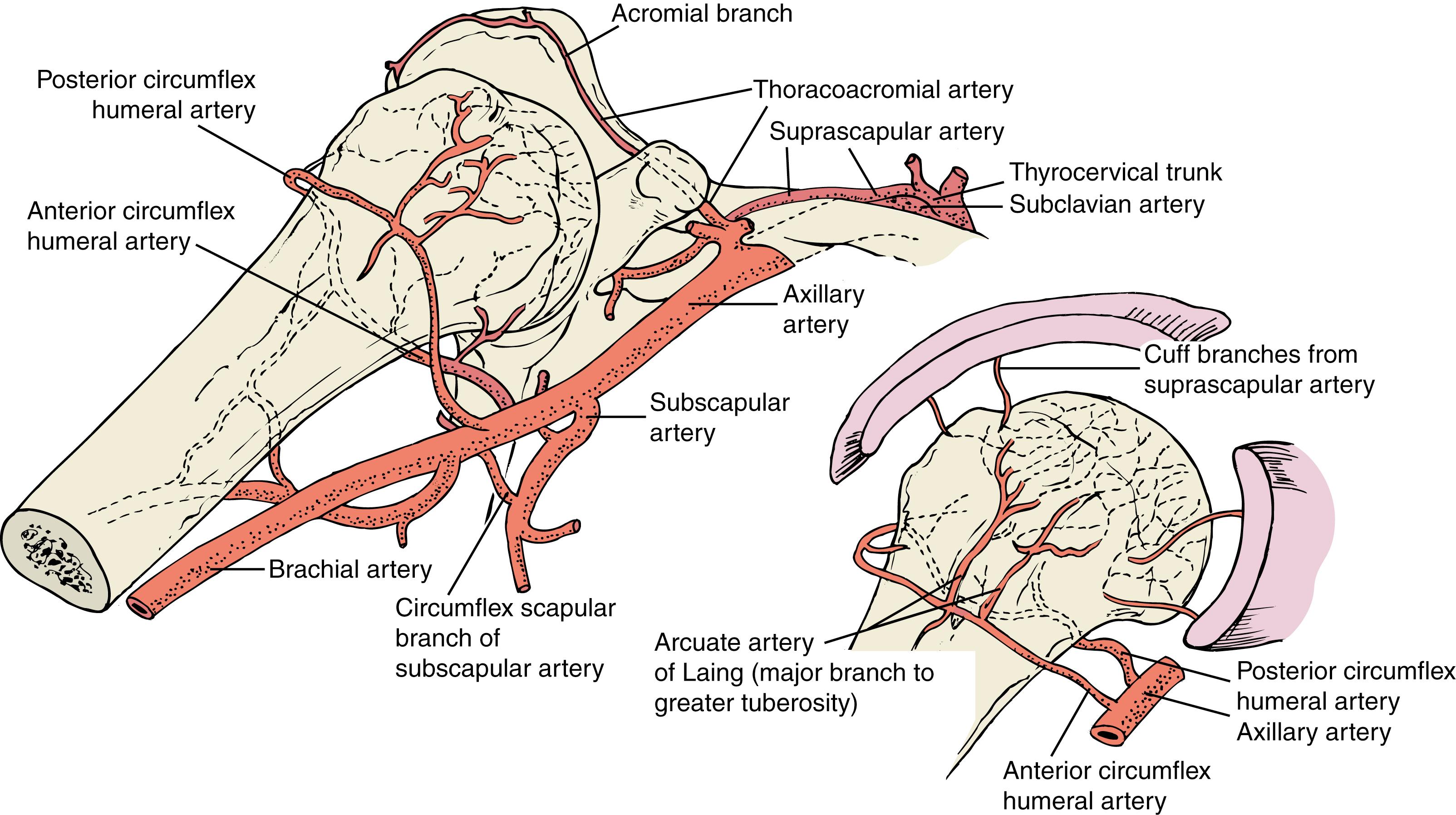
Tingart and colleagues measured total, trabecular, and cortical volumetric bone mineral density (BMD) in the humeral head. The greater tuberosity was divided into three regions, and the lesser tuberosity and articular surface were each divided into two regions. The proximal head showed a significantly higher trabecular (+46%) and cortical BMD (+15%) than the distal one. The mean trabecular BMD of the articular surface was significantly higher (+80%), and the cortical BMD was significantly lower (–11%) than that of the tuberosities. In the proximal half of the greater tuberosity, trabecular BMD was higher in the posterior than in the middle and anterior regions. Cortical BMD was higher in the middle region than in the anterior and posterior ones. In the distal half of the greater tuberosity, trabecular BMD was significantly higher in the posterior than in the middle region, and cortical BMD was significantly higher in the anterior than in the middle region. In the proximal half of the articular surface, trabecular BMD was significantly higher in the posterior region than in the anterior one. Their results point to bone sites that may provide stronger fixation for implants and reduce the risk of implant loosening.
Since Neer’s fundamental writings in 1970, , many attempts have been made to quantify or classify PHFs or fracture patterns more precisely to improve treatment and patient outcomes. Consequently, it has been difficult to compare the results of the historical with the current literature. Despite ample experience with these fractures, their treatment based on classifications remains controversial.
Early classification schemes described the anatomic location of the fracture and the mechanism of injury but did not consider the importance of fracture anatomy or displacement of the fracture. Codman noted that most PHFs occur along the lines of the former physes of the proximal end of the humerus and described four possible fracture fragments: greater tuberosity, lesser tuberosity, anatomic head, and shaft. Based on this description, Neer proposed the four-segment classification system, which included his clinical and operative findings.
The classification of proximal humerus fractures is commonly based on anteroposterior (AP) and lateral radiographs but can be difficult and unreliable. , Therefore if additional information is needed, we have a low threshold for a computed tomography (CT) scan with three-dimensional (3D) reconstructions in our institution which undoubtedly gives more accurate information with regard to fracture pattern and certainly allows better planning if surgery is intended. ,
In his study of the classification and evaluation of proximal humerus fractures, Neer originally described six groups. A segment (greater, lesser tuberosity, anatomical, surgical neck) is defined as a “part” if its displacement is >1 cm or 45 degrees.
Neer himself adapted his classification and focused on the four segments and their displacement. , The major modification was the use of a “one-part” fracture type despite the former group I. Therein all fractures with <1 cm or 45 degrees of displacement of any segment or combination of segments were included. The two- to four-part fractures were used as mentioned in his primary description ( Fig. 25.2 ). Later, the valgus-impacted four-part fracture was also included in this revised classification system. The adapted Neer classification has been used since its introduction and is still the most referenced classification for fractures of the proximal humerus. ,
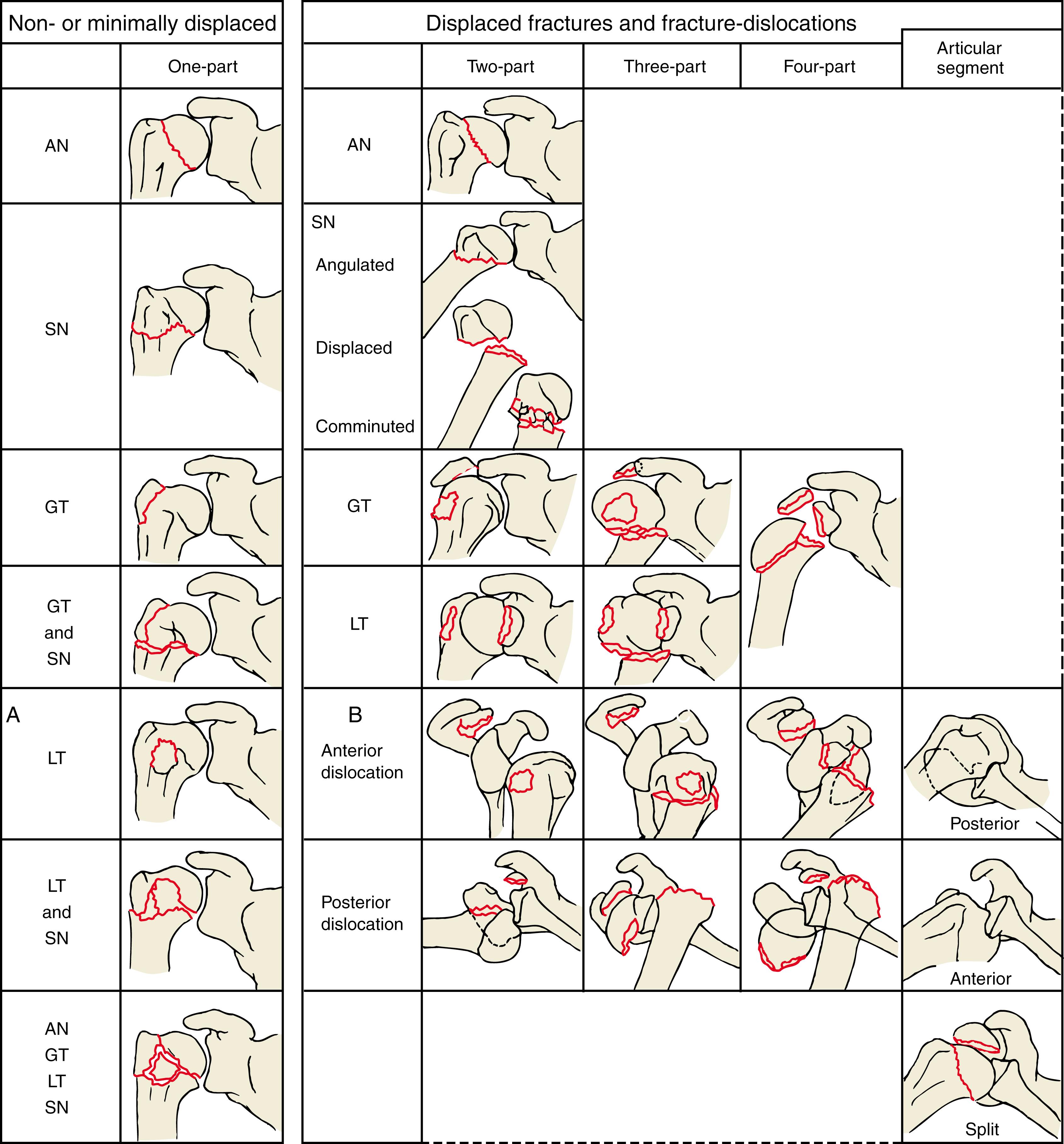
The AO/American Society for Internal Fixation (AO/ASIF) organization proposed a new classification, which was an expansion and modification of the Neer classification. The main difference was that they paid special attention to the impaction or displacement of the fracture parts and described them in a more detailed way to include the important aspect of the vascular impairment. Basically, the AO/ASIF system differentiates three types of fractures ( Fig. 25.3A–C ): extra-articular unifocal, extra-articular bifocal, and intra-articular. Each of these groups is divided into further subgroups depending on fracture location and complexity. Since the original publication of the AO/OTA Fracture Classification in 1996, there has been a lot of progress in fracture classification. Therefore a compendium was recently published updating the prior editions.
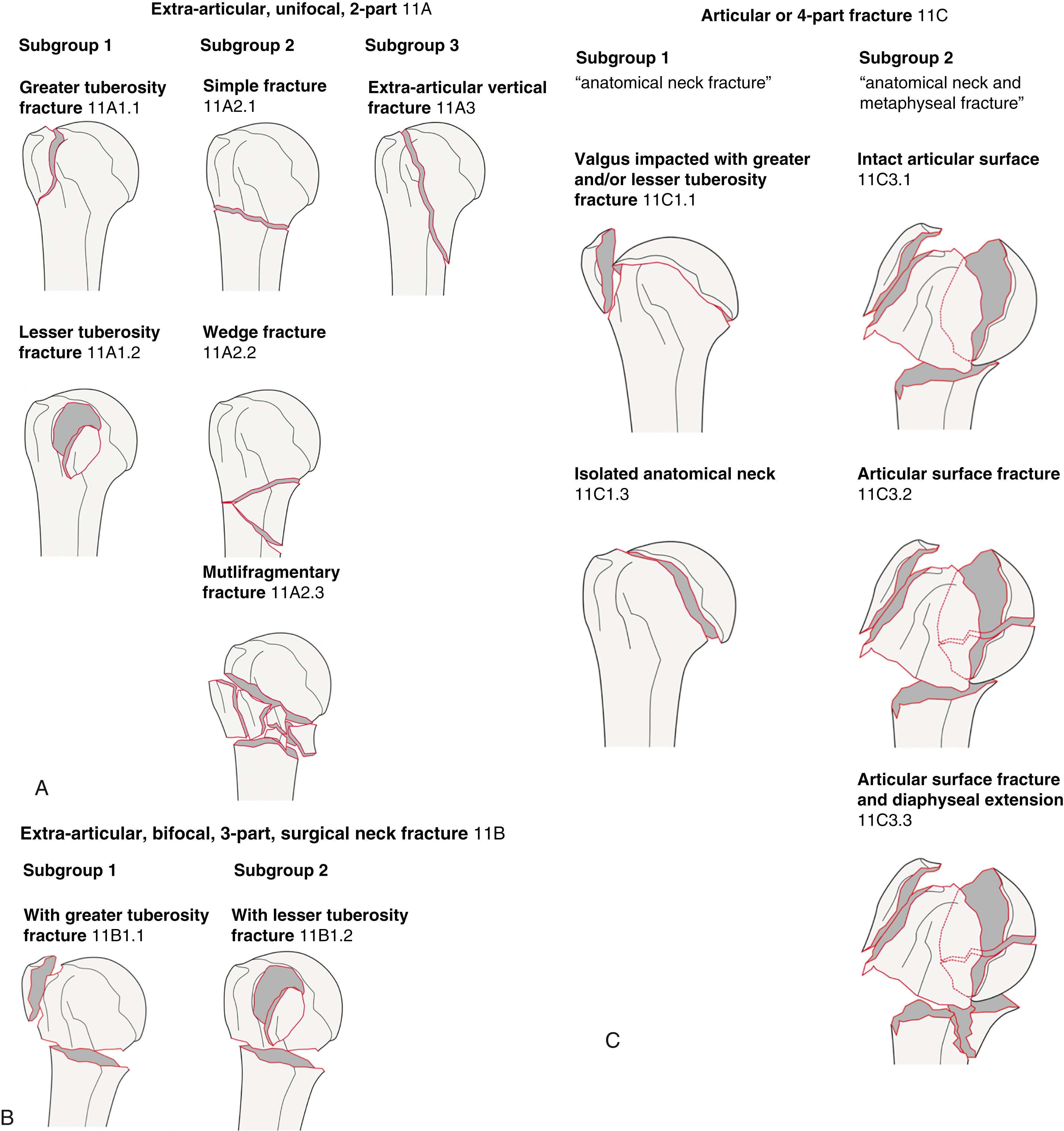
Hertel and colleagues designed a “LEGO” classification system ( Fig. 25.4 ) based on Codman’s original drawings. In this fracture description, five fracture planes are combined, which render 12 basic fracture patterns (+2 additional head-split patterns). Fracture planes lie between the greater tuberosity and the head, the greater tuberosity and the shaft, the lesser tuberosity and the head, the lesser tuberosity and the shaft, and the lesser tuberosity and the greater tuberosity. They found that a dorsomedial metaphyseal head extension of <8 mm and >2 mm of displacement of the medial periosteal hinge in fractures with isolated articular segments were good predictors for intraoperative head ischemia. However, these findings did not correlate with postoperative avascular necrosis (AVN) in a later follow-up study. ,
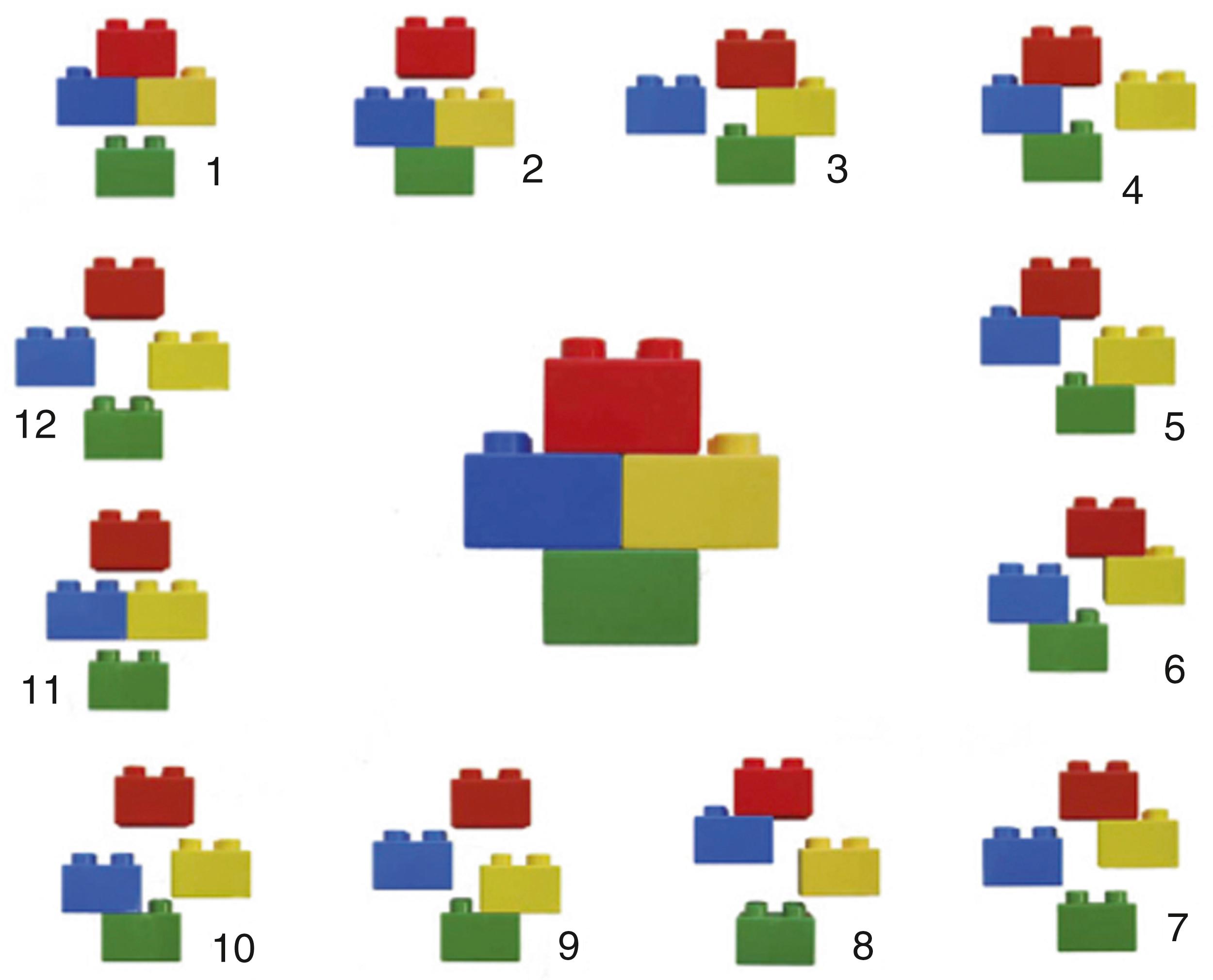
The AO/ASIF system, which is more detailed and also widely accepted, has not replaced the Neer classification. The most recent edition of the AO/ASIF fracture compendium has integrated the Neer classification to facilitate the clinical comprehension ( Fig. 25.3A–C ).
However, the main limitation in the Neer classification is the measurement of 1 cm and 45 degrees on standard radiographs, which is fundamental for the decision whether a fractured segment becomes a “part” with subsequent surgical consequences. Therefore the reproducibility, or lack thereof, of the Neer classification has been the subject of many studies. In most of these studies, the inter- and intrarater reliability were only moderate. The experience of the observer and also the quality of radiographs are important factors influencing the reliability. Also, the benefit of the addition of CT to plain radiography has been studied, and a slight increase in intraobserver but no change in interobserver reliability was found. Comparisons of the reliability of the AO/ASIF system with the Neer classification showed advantages for the latter. , , Brunner and colleagues could improve their inter- and intrarater reliability from moderate to good or excellent after the use of 3D volume–rendered CT scans. Additional information from CT scans plays a more important role in modern fracture classification of the proximal humerus and has, therefore, been used in recent studies. , As mentioned before, the authors have a low threshold for a CT scan with 3D reconstructions to obtain information with regard to fracture pattern, segment dislocation, and treatment decision.
Multiple, recently performed prospective randomized studies on conservative versus operative fracture treatment in elderly patients with three- or four-part fractures consistently have shown no functional benefit with surgery. , , , Therefore it seems that in the setting of elderly or unfit patients, the discussion of fracture classification becomes secondary because the consequences for further treatment are questionable. However, in younger patients with high demand, a clear understanding of the fracture remains critical to restore full shoulder functionality. Shrader showed that the understanding of complex fracture patterns rather than their classification should be focused on. Therefore in the authors’ institution, CT scans are used for a better understanding of fractures with subtle but potentially relevant displacement and for fractures where surgical treatment is planned. Based on that, the authors use the Neer classification and pay special attention to certain fracture patterns and configurations that have been found to behave in a particular manner and are described in the following section.
In an epidemiologic study on 1027 proximal humerus fractures, a 19% incidence of isolated greater tuberosity fractures was found and 5% thereof were fracture-dislocations. These fractures need special mention because their classification as well as treatment remains controversial. Mutch and colleagues have described a classification of greater tuberosity fractures that is based on fracture morphology. It separates fractures into three types: avulsion, split, and depression. They found a significantly greater number of glenohumeral dislocations in the depression (46%) compared with the avulsion (21%) and split (25%) fracture types. Neer suggested treating isolated greater tuberosity fractures with >1 cm of displacement operatively. Park introduced a strategy depending on the patient’s activity level. Given concerns for subacromial impingement–related pain and decreased function, he recommended surgical fixation in young and active patients with a displacement of >5 mm and in athletes and overhead laborers with >3 mm. This strategy has been supported by the findings of a biomechanical study performed by Bono and colleagues. They found significantly increased abduction forces of the deltoid muscle with a superior displacement of the greater tuberosity of 5 mm and 1 cm. Also, other authors agreed with the surgical treatment with a displacement of >5 mm. , Recently, Nyffeler et al. developed a measurement method, which allows predicting a possible subacromial conflict on standard AP radiographs, considering not only the displacement of the fragment, but also the width of the subacromial space. A so-called Impingement-Index was calculated and biomechanically validated. They conclude that reduction of a displaced greater tuberosity fragment should be considered if the Impingement-Index is ≥0.7. Parsons et al. found difficulties in evaluating the exact displacement of the greater tuberosity on plain radiographs and recommended the use of an AP view with the arm in 30 degrees of external rotation. Depending on the radiographic projection, about 50% of their involved experts would have recommended surgery for 5-mm displaced fractures. The evidence on this topic is not strong, and the treatment therefore mainly depends on the surgeon’s preference. In active patients, the authors use CT scans to determine the exact direction and amount of displacement and consider arthroscopic or open surgical reduction in cases with >5 mm of displacement. In elderly patients with low bone quality, the threshold for conservative treatment is higher and at least up to 1 cm of displacement.
Fracture morphology significantly influences the technical aspects of surgical management. Avulsion-type fractures involve a small fragment of bone and the fracture line is horizontal. The mechanism is probably similar to rotator cuff tears with the tendon avulsing a fragment of bone rather than causing a cuff tear. These fractures usually can be treated conservatively. Should fixation be required for displaced fractures, an (arthroscopic) double-row suture or suture bridge technique can be performed.
Split-type fractures involve a large fragment with a vertical fracture line. For surgical fixation of this type of fracture, a low-profile suture plate may be used but other techniques including suture fixation, tension band, screws, and conventional plate fixation have also been described.
Depression-type fractures involve a fragment that is displaced inferiorly. This lesion is essentially a very lateral Hill-Sachs-type lesion due to impaction of the entire greater tuberosity beneath the inferior surface of the glenoid during glenohumeral dislocation. The authors usually treat these fractures conservatively. If pain or functional impairment persists, a magnetic resonance imaging (MRI) to assess the rotator cuff should be performed.
Since Neer’s definition, head-split and head-impression fractures are also mentioned together with fracture-dislocations. The incidence was found to be about 6% anterior, 0.4% posterior, and 0.7% of articular surface fractures. The term “head-split” is often associated with the development of AVN, even though this condition can only be considered a poor-to-moderate predictor of humeral head ischemia. In general, a clear definition and classification of head-split fractures are lacking in the literature and historically have been based on plain radiographs. , , This makes the already scarce number of outcome reports even more difficult to interpret. Peters and colleagues recently proposed a classification system of four distinct head-split fracture patterns, based on the available evidence and their own clinical experience:
Type I: Head-split fracture with the fracture line within the posterior half of the humeral head with the larger head fragment located anteriorly.
Type II: Head-split fracture with the fracture line within the anterior half of the humeral head with the larger head fragment located posteriorly.
Type III: Head-split fracture with a loose or free-floating central fragment.
Type IV: Comminuted head-split fracture.
In a recently published paper by the same group, 30 patients with a head-split fracture were retrospectively evaluated, with a mean follow-up of 49 ± 18 months (range: 12–83 months). Of those 30, 24 were treated with ORIF, 4 with rTSA, and 2 with HA. The complication rate was 83% overall and 88% for primary ORIF, 75% for primary rTSA, and 50% for HA. The revision rate was 29% for ORIF (excluding the three cases of implant removal) and 0% for primary rTSA and hemiarthroplasty (HA). No factor was found to be associated with clinical failure except for a trend for worse outcomes in patients with higher BMI; the above-mentioned classification could not predict clinical outcome. However, patients who underwent revision procedures had worse clinical outcome scores overall. rTSA may be the most predictable treatment option for head-split fractures in elderly patients.
Fracture-dislocations need emergent treatment and special attention should be paid to locked anterior greater tuberosity and posterior lesser tuberosity fracture-dislocations. Hersche and Gerber described a series of these fractures with additional occult anatomic or surgical neck fractures. During the reposition maneuver, the head fragment stayed in its primary locked anterior or posterior position and the occult fracture line was displaced. All of these patients developed AVN. Therefore the authors first rule out such an obscure fracture by CT scan when the radiograph is suspicious. When a neck fracture is excluded, a careful try of closed reduction under general anesthesia can be made. If a fracture of the anatomic or surgical neck is detected on the CT scan, one careful try of closed reduction under fluoroscopy can be done with standby for ORIF in the operating room. In situ ORIF before reduction may be considered if there is not much fracture displacement; otherwise, the head needs to be carefully reduced through the rotator interval (which can be extended into a subscapularis tenotomy if needed). If the fracture is not displaced, the plate can be used as reduction-aid only and be removed afterwards with “conservative” fracture treatment ( Fig. 25.5 ).
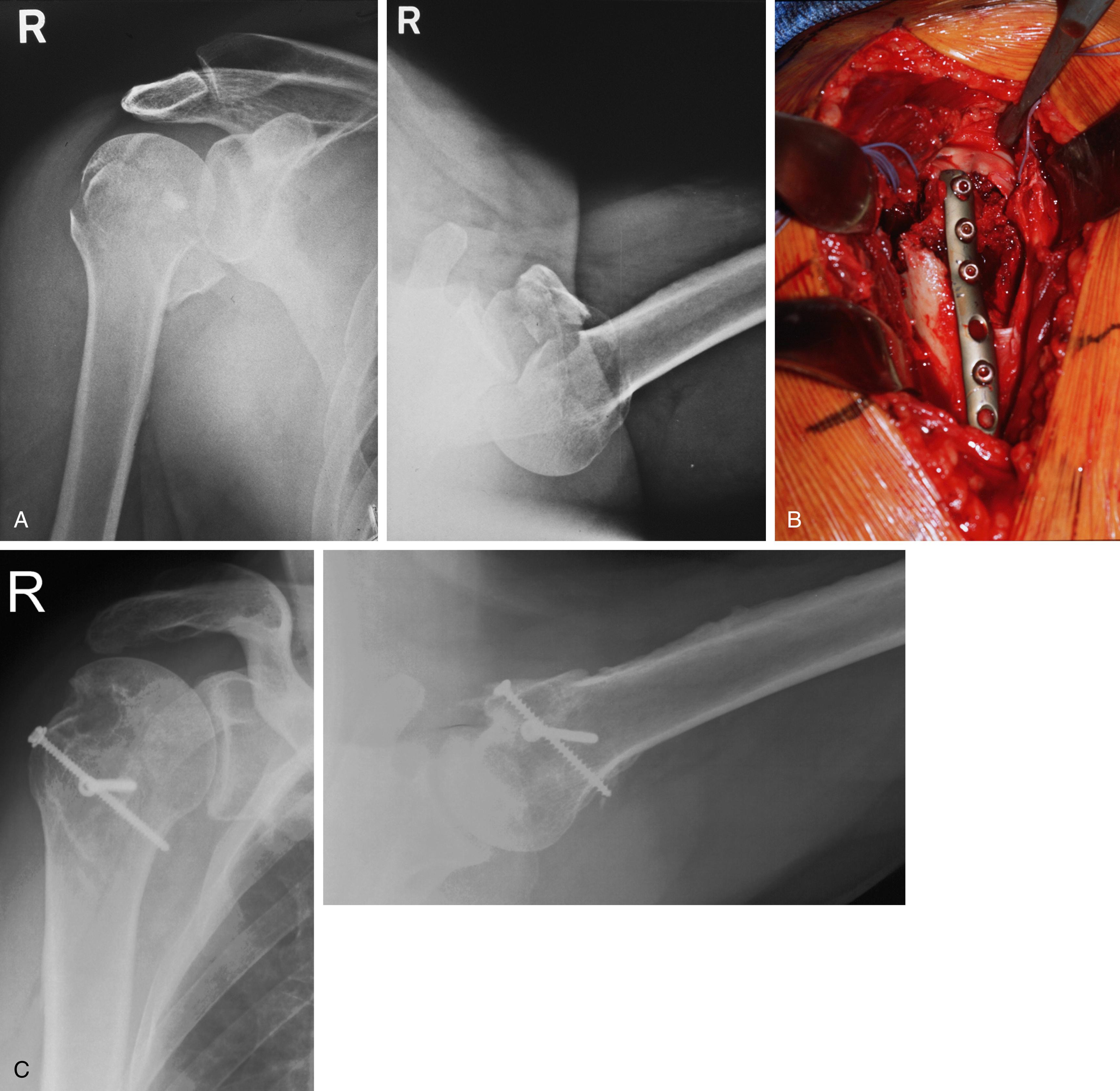
Neer proposed primary prosthetic replacement for four-part fracture-dislocations and articular fracture involvement of >50% of the humeral head. However, posterior fracture-dislocations should be mentioned separately. Despite their rarity, Robinson et al. described a series of 26 younger patients with posterior fracture-dislocations. They were treated with ORIF and had excellent functional results after 2 years. Please see Technique Spotlight: Open Reduction and Bone Grafting of reverse Hill Sachs ( Chapter 24 ) for a detailed description of one way to manage these challenging injuries in the acute setting.
Despite voluminous literature on the treatment of fractures of the proximal humerus, there is still no standard of care, and a lot of controversies remain. The highly variable nature of this injury, the difficult classification of the fractures, and the high number of treatment strategies with new implants (that are promoted by manufacturers and surgeons) are possible reasons for these disagreements. Prospective randomized studies comparing different treatment options for specific fracture types are relatively rare, and the management and especially the surgical technique are mainly based on the surgeon’s experiences and preferences. This section gives a general view on the nonoperative and operative management of fractures of the proximal humerus based on the current literature.
Become a Clinical Tree membership for Full access and enjoy Unlimited articles
If you are a member. Log in here